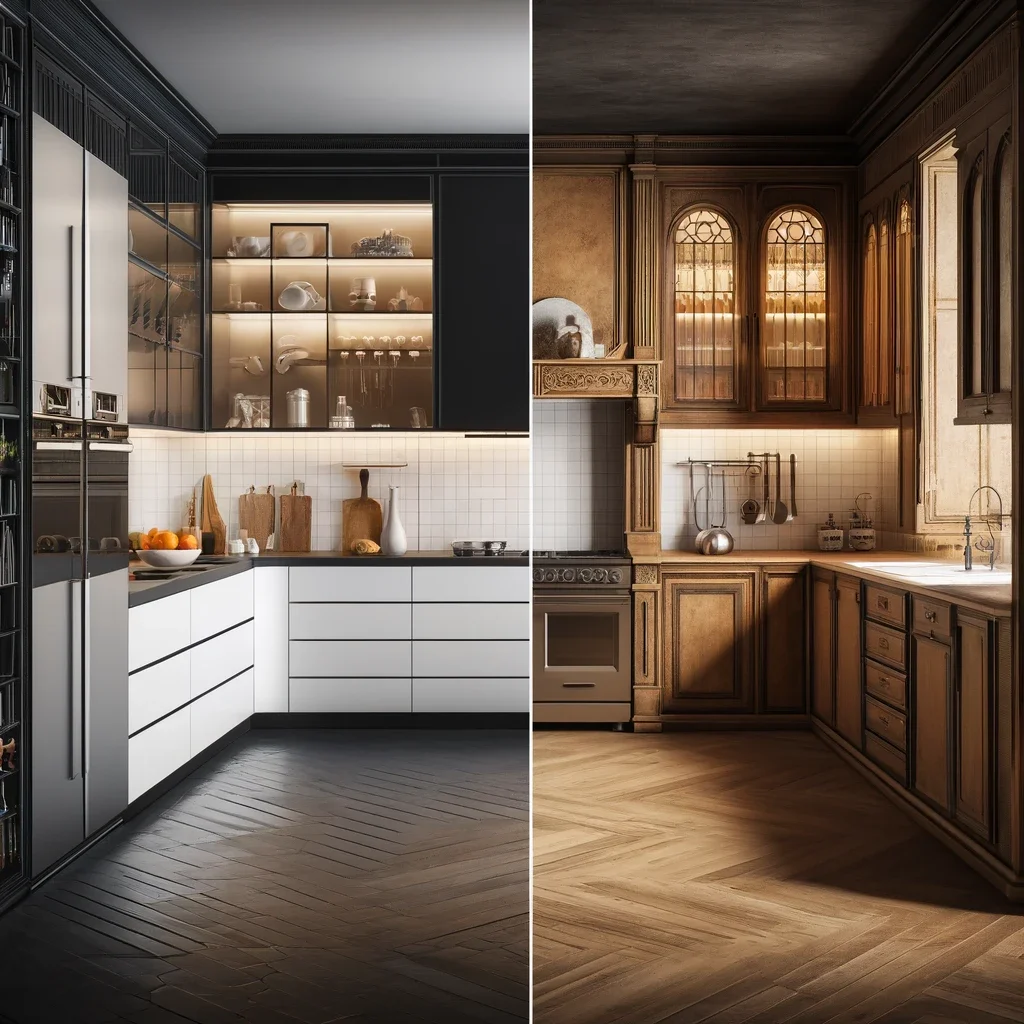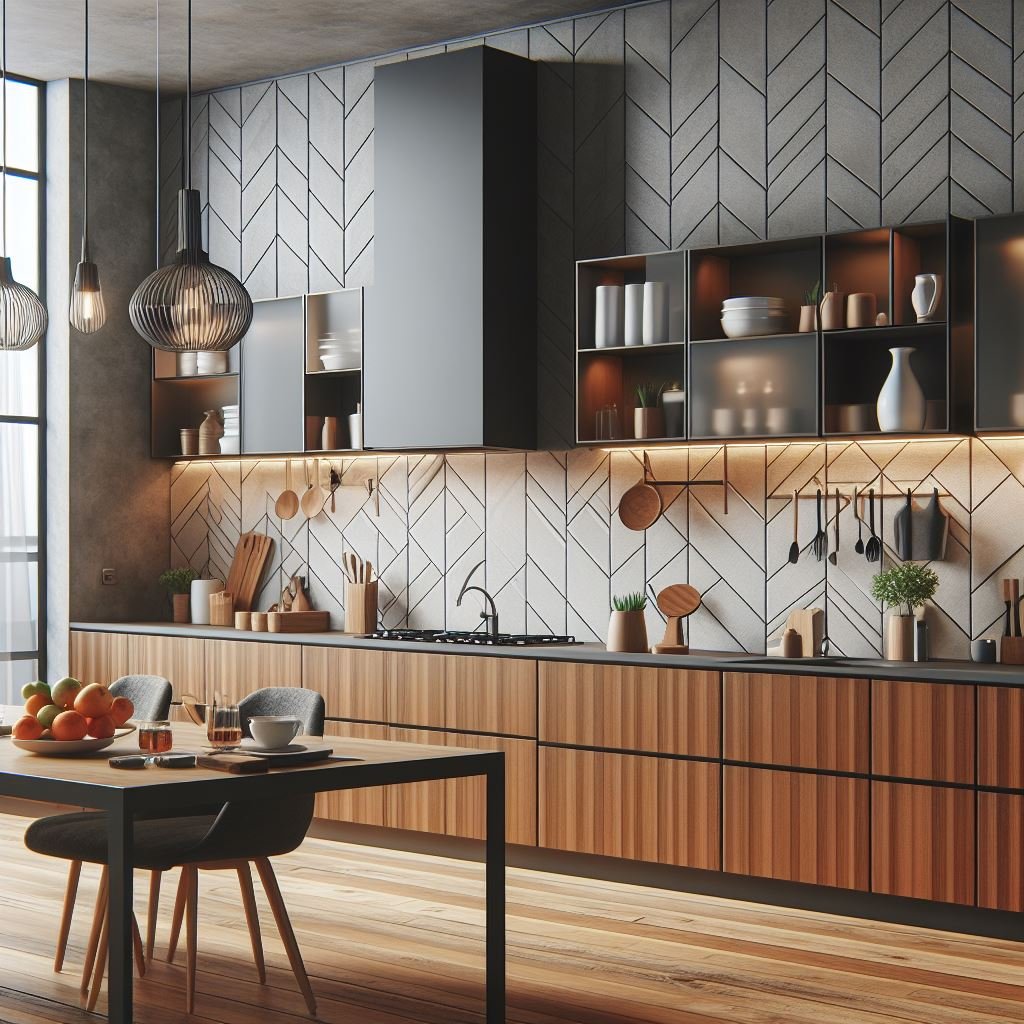Cabinets
Cabinets, more than just storage spaces, are a key component in the functionality and aesthetics of any kitchen. From rustic wooden cupboards to modern integrated storage solutions, cabinets have evolved to meet changing needs and contemporary lifestyles.
Choosing the right cabinets can transform a kitchen from a merely functional space into a welcoming and organized environment. It’s not just about storing food or kitchen utensils; it’s about how to integrate this essential element into the overall flow and design of the kitchen, making every activity, from cooking to socializing, more enjoyable and efficient.
When considering cabinets for your kitchen, it’s crucial to think about the overall style of the space. A minimalist kitchen might benefit from cabinets with clean lines and a monochromatic color palette, while a rustic kitchen might shine with sturdy wooden cabinets that exude warmth and tradition. Each kitchen style dictates a different approach in cabinet selection, not just in terms of design but also in the choice of materials and finishes.
How Functionality Plays a Role in Cabinets:
Functionality also plays a predominant role in the selection of cabinets. Internal organization, ease of access, and space optimization are crucial aspects that can make a big difference in the daily dynamics of the kitchen. With a variety of innovative solutions available, from pull-out storage systems to cabinets with smart accessories, choosing the right cabinets can significantly enhance your kitchen’s efficiency.
Beyond aesthetics and functionality, the maintenance of cabinets is an important factor to consider. The materials used should not only complement your kitchen’s style but also be durable and easy to clean. From lacquered wood to high-resistance laminate finishes, knowing the materials and their maintenance requirements will help you keep your kitchen looking impeccable and welcoming for longer.
Cabinets are much more than simple storage spaces in the kitchen; they are crucial elements that affect the functionality, aesthetics, and comfort of this important home space. With careful and thoughtful selection, cabinets can enrich the culinary and aesthetic experience, making the kitchen a place not only for cooking but also for living and enjoying.
By developing this outline and continuing with the text, you can create a detailed and enriching blog article that guides readers in choosing the perfect cabinets for their kitchen, combining functionality, style, and maintenance to achieve the best result in their culinary space.
Innovative Trends in Cabinets
Technology in Cabinets
The incorporation of technology in kitchen cabinets is revolutionizing how we interact with this vital space. LED lighting is an excellent example, offering an energy-efficient solution that enhances visibility inside the cabinets. These lights can be activated by motion sensors, automatically illuminating the space when a door is opened or a person approaches. Additionally, automatic opening systems are becoming increasingly popular, allowing access to cabinets with a simple touch or even voice commands, making them especially useful when hands are full or dirty.
Sustainable and Eco-Friendly Solutions
The focus on sustainability has moved into cabinet design, with an increasing demand for eco-friendly materials and sustainable production practices. Woods certified for responsible forest management, recycled materials, and non-toxic finishes are some of the preferred options for environmentally conscious consumers. Additionally, priority is being given to durability and ease of repair to minimize environmental impact, opting for cabinets that are not only beautiful and functional but also planet-friendly.
Custom Designs and Tailored Solutions
Customization is a key trend in cabinet design, reflecting the desire for kitchens that perfectly fit individual needs and lifestyles. This includes cabinets designed to fit unusual spaces, make the most of every available inch of space, and meet specific storage requirements. Tailored solutions can include special features such as pull-out shelves, adjustable dividers, and internal organizational systems that help keep everything in order and easily accessible.
Choosing Cabinets Based on Kitchen Style
The choice of cabinets should harmonize with the overall style of the kitchen, reflecting both the desired aesthetics and the functional needs of the space. Here’s how cabinets can adapt to different kitchen styles, along with some tips for selecting materials and finishes.
 Traditional vs. Contemporary Kitchen
Traditional vs. Contemporary Kitchen
- Traditional Kitchen: This style is characterized by ornate details, warm colors, and natural materials. Traditional cabinets often feature decorative moldings, raised paneling, and finishes in natural or painted wood. Handles may be made of metals with classic finishes like bronze or copper. The choice in this style should evoke a sense of warmth and timelessness.
- Contemporary Kitchen: In contrast, contemporary kitchens favor clean lines, neutral colors, and a minimalist aesthetic. Contemporary cabinets often have smooth, unadorned surfaces and hidden or push-open mechanisms to maintain a clean look. Materials like glass, metal, and high-pressure laminates are common, and finishes tend to be matte, satin, or glossy for a modern look.
Cabinet Styles: Minimalist, Rustic, Industrial
- Minimalist: This style focuses on simplicity and functionality, with a “less is more” mantra. Minimalist cabinets typically have an uncomplicated design, with monochromatic colors and discreet hardware. Materials like stainless steel, glass, and neutral-colored laminates are popular in this design.
- Rustic: Rustic kitchens evoke a country or mountain feel, with a focus on naturalness and robustness. Rustic cabinets often use raw or aged wood, with features like visible knots and grains. Finishes are usually matte or have a distressed effect to highlight the rustic character.
- Industrial: Inspired by factories and urban lofts, the industrial style combines raw and unfinished elements with a modern aesthetic. Cabinets in this style may incorporate metal, reclaimed wood, and glass, with details like visible pipes and industrial-style mechanisms.
 Tips for Selecting Materials and Finishes
Tips for Selecting Materials and Finishes
- Durability: Choose materials that not only complement the style of your kitchen but also offer durability and ease of maintenance. For example, laminate surfaces withstand daily wear and are easy to clean.
- Aesthetics and Functionality: Consider how the finishes of the cabinets will affect both the appearance and functionality of the kitchen. Glossy finishes can make a small space appear larger but may also show fingerprints and smudges more easily.
- Design Consistency: Ensure that the cabinets integrate well with the rest of the kitchen, including appliances, countertops, and flooring, to create a cohesive aesthetic.
Function of Cabinets in the Kitchen
Storage and Organization
Cabinets are essential in the kitchen for storing and organizing a wide variety of items, from dry and canned goods to cookware, dishes, and small appliances. They help maintain order and cleanliness in the kitchen, sorting items so they are easily accessible and well-organized. Well-designed cabinets maximize the use of available space, with shelves, drawers, and specific compartments for different types of products, facilitating the management of food and utensil inventory and helping to avoid clutter.
Preservation of Food and Utensils
Beyond storage, cabinets play a crucial role in the preservation of food and utensils. They provide a dry and cool environment that helps keep food in good condition for longer. Some cabinets are equipped with special features like temperature control or airtight storage zones to better preserve certain types of food. Additionally, they protect utensils and dishes from dust, grease, and other common kitchen contaminants, keeping everything clean and ready for use.
Contribution to the Aesthetics and Flow of the Space
Cabinets are not only practical from a storage and functionality standpoint but also have a significant impact on the aesthetics and flow of the kitchen space. Their design, color, and material can complement or contrast with the rest of the decor, contributing to the overall ambiance and style of the kitchen. Well-designed and strategically placed cabinets can enhance the flow of the space, facilitating movement and efficiency during food preparation and cooking, and creating a more enjoyable and functional experience in the kitchen.
In summary, cabinets are essential elements in the kitchen that serve to store and organize, preserve food and utensils, and significantly contribute to the aesthetics and functionality of the space. Choosing the right cabinets that align with the practical and aesthetic needs of the kitchen can transform the culinary experience, making the kitchen a more efficient, pleasant, and welcoming place.
Read more
